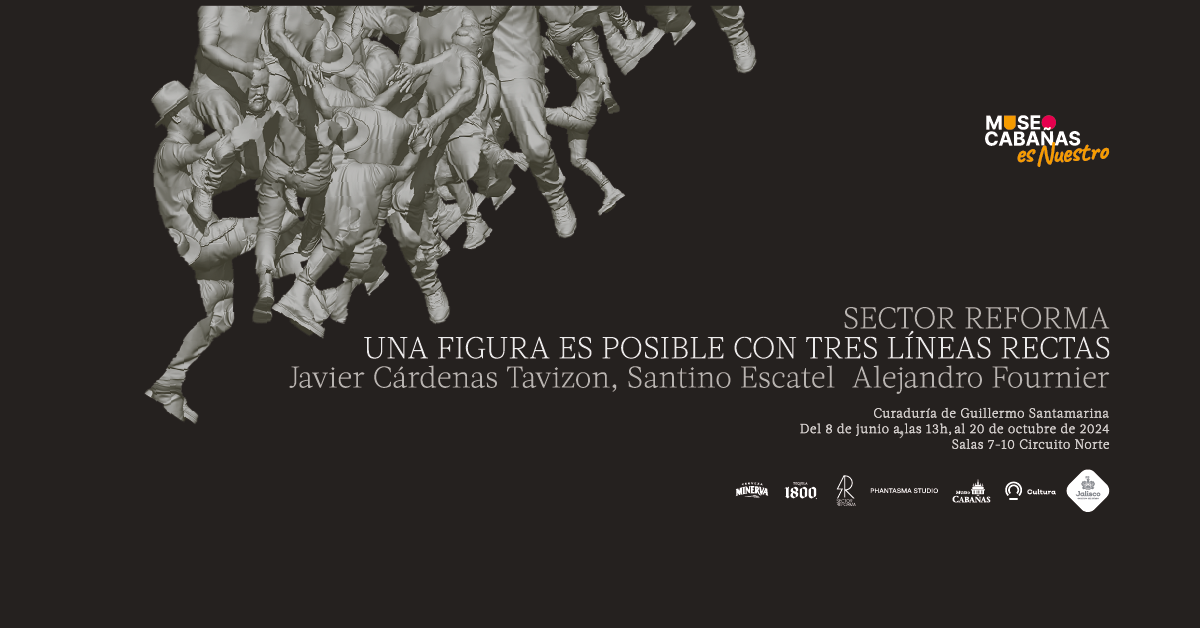

Alongside the presentation of this body of work whose sails, oars and singular narratives are disseminated throughout this remarkable geography, the three-phase Sector Reforma organization wishes to share with the public visiting the great Museo Cabañas and the community linked to the evolution of Jalisco contemporary art the celebration of two decades of its creative activity, the confluence of ideas and personal capacities, of invention, of play, odyssey, of administrative management, co-participation and configuration of works and projects with other talents, of embraces, as well as the recurrent activation of a simultaneity model whose radius has notably left its mark in conventional spaces, in site-specific situations and in public squares, always with an emphasis on fellowship and generosity.
Based on this approach of multidisciplinary work, with its vibrant ubiquity, Sector Reforma has reconciled a recurrent model of processual configuration (set up both for creative work and for the certification of an experimental axis and, of course, also to ensure the deployment and continuity of a network destined for reunions and conversations) both of its collective identity, and in favor of the development of their personal inclinations, as well as with an inertia that seems unstoppable with the activities sown in their headquarters (initially in a building in the old neighborhood of Analco or, more recently, in a property in Santa Teresita), again and again together with a hundred participants in many creative aspects, regardless of region or nationality, generation or gender privileges. It is an authentic institution with countless testimonials of tenacity, risk and commitment to the rhythm of the imagination and talent of Javier Cárdenas Tavizon, Santino Escatel and Alejandro Fournier.
The Possibility of a Figure with Three Straight Lines presents the jóurney through the abstractions of an ecosystem (illuminated by the poetics of the space of a hypothetical boat) through which, as if navigating a metaphysical landscape, exploratory forces and layers of semantic intention are cited, with an insistent web of abstraction, geometry, signification and morphological enquiry; there is a circular analysis of compositional paradigms, along with flexions of displacement and assimilation challenging the logic and transcendence of a nuclear concept: shared processes. The process is shared in the constancy of a structure of three fuels: three artists. The result is a structure that emphasizes its organic tripod category and its nautical mood, following a panorama through which brief narrative islands emerge, Kantian floats, drifting with the evocation of local tales, among others, in a furrow where pseudo-scientific discernment coefficients, psycho-geographical research and poetic architecture flow.
The Possibility of a Figure with Three Straight Lines is a coupling experience, like the mast of a sail consigned to the harmonious functioning of a dynamic task in recurrent contingency and risk. It is a circumstance of vitality, of reasoning and of fantasy as influences for the activation of what Peter Sloterdijk calls in his notes on the great interior of the realities of the present time, contrasting the circumstances of a right-wing state and the very complex ones of a left-wing one, manifested in the last chapter of his book to study a philosophical theory of globalization, The latter is a common and not very heterogeneous category and condition of existence, particularly confronted with the developed concept of the local, which in the case of this exhibition of Sector Reforma’s work is transferred to the category of the shared trance of “non-ordinary” life, as we often recognize that of an artist and their respective projections. That way of being that usually identifies itself as centrifugal to the social domain, at least as an illusion, though not beneficial, not useless, nor derogatory to the “normal” that presumes to be unequivocally profitable and demanding, especially today more than ever, to productive social participation; however, it is also recurrently referred to as an “inevitable” circumstance that even assumes and inspires degrees of marginality, vindicating its canon – art – essential in the dimensions of humanism. The author then points to “… the demands of that meta-life, whose reference to the world will forget immunity, favouring the strange, the inclusive condition, the non-selective, symmetrical, duty-free, as well as discretionally compressible and reversible clause…” the boundless reason, bathed in experience and personal free will and the consciousness of the common good.
Thus, here there is an abstraction that involves a voyage, a game and a lot of work on the horizons of the meta-life navigated with the resource of a fertile —and certainly eclectic— fusion of instruments, supports, ideas, images and sounds, as well as of associations and obligatory renunciations. There is the trace of a curious and sagacious entity that favours the multiplication of links between reality and the unusual, perhaps arrogating the chaos, the uncertainty of a misty voyage (living for and in contemporary art are not docile comforts) but, fortunately, as is the case with the pulses and vital attributes of these three oceanic personalities, never doubting the conquests of radiant moorings that Sector Reforma finds and will continue to find, a figure in three straight lines.
Guillermo Santamarina, 2024
(20 more sectors to come)